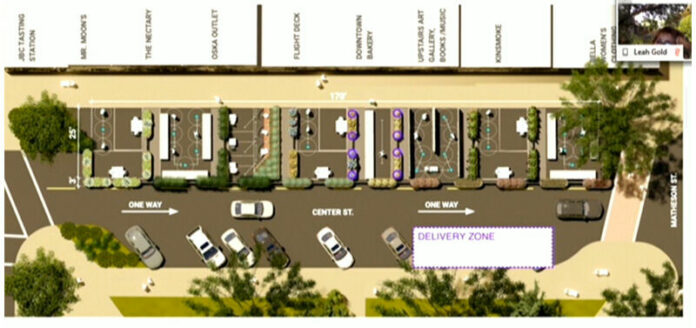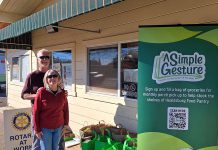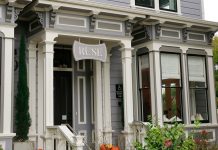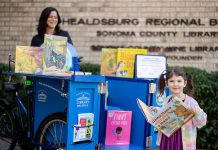Approves resolution for outdoor activity permit to allow businesses to expand onto sidewalks
The Healdsburg City Council unanimously approved a resolution at their meeting on June 1 that will create an outdoor activity permit process which would allow local businesses to use the public right of ways to extend their retail space or restaurant to provide more room for customers. Permits for outdoor activity in public right of ways will be available for the duration of the COVID-19 crisis.
Council also directed city staff to explore various options for street closures in the downtown plaza area to allow more room for pedestrian use and for businesses to utilize space for outdoor dining or retail.
Outdoor activity permit
“We’ve had a number of discussions with businesses to involve more of the outdoor spaces in the public right of way for their operation. The goal of this discussion was to make sure that under social distancing, retailers and restaurants had enough space to successfully operate,” said David Kiff, the soon-to-be interim city manager.
For the outdoor activity permit, business owners would need to fill out the permit application, provide a simple site plan — a sketch of proposed sidewalk use for dining for instance — and show there is insurance with the use and that it’s ADA compliant.
“It could be something like two tables and four chairs or a couple of retail racks brought out into the sidewalk or an alley,” Kiff said.
Kiff said if permits and the outdoor activity use is successful, council could decide to extend the program if they wished to do so.
To get to this concept of right of way permits, Kiff and staff had several Zoom meetings with local businesses to get input on the idea from folks with retail or restaurants on North and Center Streets and around the Plaza.
“The consensus generally was that everybody was pretty on board with accessing more public spaces like sidewalks and parking spots,” Kiff said. “Generally the retailers said that they might use this in a more limited way than the restaurants.”
However, there were concerns about who would enforce facial coverings and social distancing protocols and what restroom access would be like.
Healdsburg Mayor Leah Gold asked if the city would have to consider open container rules if people wanted to have wine or beer with their meal when seated out on a sidewalk.
Kiff said the California Department of Alcoholic Beverage Control (ABC) has released fairly liberal guidance in that regard and generally, an ABC licensee can add to his or her premises footprint that is somewhat adjacent to the premises and serve that in those adjacent locations.
“If the alcohol wandered off past that point we’d have to adjust our open container rules, but as we read the ABC guidelines, it is permissible to just expand the footprint within a reasonable area in an area where you have control over,” Kiff said. “You’d probably have to have little barriers around it like a very small beer garden and you couldn’t have alcohol leaving that premises.”
To close or not to close streets, that is the question
The city is also exploring the possibility of partial or full street closures in the downtown plaza area to allow for extended outdoor use for restaurants and retail.
Some ideas discussed during the meeting include streets closed to vehicles for a specific duration of time or implementing full or one-way street closures.
One concept design by city staff showed what a one way street closure could look like on Center Street where there are a variety of businesses, such as retail with Mr. Moon’s, wine tasting with the JCB Tasting Salon and dining with Downtown Bakery and KINSmoke.
The concept drawing depicts one lane for traffic going one way and the other lane closest to the sidewalk, being used for dining or art and retail displays. The concept also includes a designated delivery zone.
Kiff said they’ve reached out to a few businesses in the Plaza area and most have concerns about vehicular closure since it could impede curbside pickup business or make it difficult to receive deliveries. Kiff reported that there was less of a concern about having a one way street set up.
Brad Barmore, one of the owners of KINsmoke, said he would “absolutely, without question” love the ability to be able to provide outdoor dining options and liked the idea of utilizing the sidewalk and parking spots to be able to do so.
“I could fit two tables (with the social distancing guidelines) on the sidewalk, but with the parking spots I could do four to six tables,” Barmore said. “I grew up in San Jose… and a lot of businesses do this. It helps businesses and also encourages public transportation.”
Barmore said he is “pumped and excited” that the city is having the discussion and exploring options for street closures.
During public comment, resident John Murphy opined that streets should be closed completely if the city were to pursue the idea.
“Half measures do not give half benefits. Use removable traffic controls to allow for delivery and pickup only from 7 to 9 a.m. This would allow the eateries to use the maximum area for dining options and bring additional foot traffic back to the area for retail establishments,” he said.
Other locals also supported the street closure idea, and some pointed out that other cities have enacted street closures or “slow streets” to allow more pedestrian and cyclist access.
“A lot of European cities open streets with just soft closure barriers such as signs and traffic cones. This still gives emergency vehicles access to the roads closed to vehicle traffic. Oakland has enacted ‘Oakland slow streets’ which consists of 15 corridors 10 miles in length where people can walk, cycle and run while social distancing,” said local, Walter Niederberger.
He said while some business owners may be reluctant to accept street closures because of the already strained economic situation, the one-way street solution could give these businesses a chance to figure out what works and what doesn’t work.
Councilmembers were open to the various street closures ideas, but noted that ultimately it will be input from businesses and residents that guide what a street closure could look like.
Gold suggested doing a pilot program one block at a time to see how it goes.
“My comment on that is just to allow the city staff to be really flexible and to give a lot of different options,” said councilmember Shaun McCaffery. “I think what was presented to us tonight looks pretty good, although I do understand some of the concerns of the people about having the full street closed … I think if we are able to do this I think it could become something really special and really activate the area.”
Councilmember Joe Naujokas supported the idea of the partial street closure with the one way model.
“When the idea first started floating around of closing streets, it really lit the eyes of our residents; it clearly struck a positive chord … I think there are some places that are better than others (for a street closure),” he said. “Center between Plaza and Matheson streets could be a good place for a closure and would extend the plaza.”
Naujokas said a partial street closure could really bring some energy to the area.
“I think staff has come up with a pretty good schematic with these one-way streets. If I had my way, we could get rid of the parking on the south side of Matheson and the eastside of Center and the north side of Plaza or make it parallel parking to expand out the pedestrian walkway area. From a phased approach, I would prefer the one way,” Hagele said.
Vice Mayor Evelyn Mitchell agreed with what her colleagues said and liked the idea of a pilot program to test out the waters.
The next step is for city staff to glean more community input and reach out to local businesses. They’ll then return to council at a future date to discuss more specific options and ideas for street closures.









